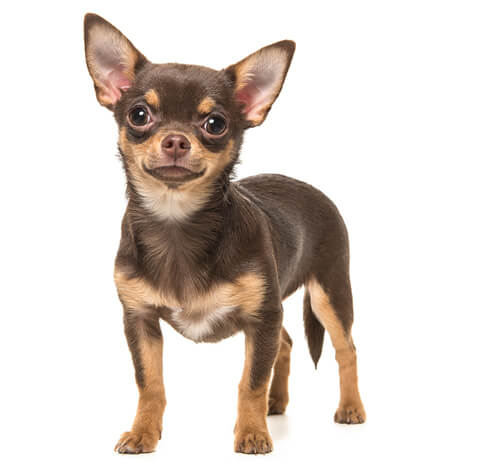
Chihuahua (Smooth Coat)
Graceful, alert and highly intelligent, the Chihuahua is an excellent pet for families with gentle, patient children. An ancient breed from Central America, the Chihuahua can be longhaired or shorthaired. Both coat varieties are easy to maintain. An ideal city dog, the Chihuahua requires little exercise but can be sensitive to cold temperatures.
DID YOU KNOW? In the hit film “Legally Blonde,” a Chihuahua starred as “Bruiser,” the pampered pet of Elle Woods, played by Reese Witherspoon.
The need-to-know
- Dog suitable for experienced owners
- Basic training required
- Enjoys gentle walks
- Enjoys walking half an hour a day
- Little toy dog
- Minimum drool
- Requires grooming once a week
- Non hypoallergenic breed
- Very vocal dog
- Guard dog. Barks and alerts
- Great with other pets
- Great family dog
Personality

The Chihuahua tends to bond closely with one or two people, with whom they will be curious, lively and intelligent, as well as deeply and constantly affectionate. However, without adequate socialisation, the breed will not take kindly to strangers and can appear nervous, yappy and even snappy. Chihuahuas must be socialised as early as possible or they will become anxious in new environments and will not get along with strangers, children and other household pets.
The Chihuahua will suit an owner who may have little space in their homes but still want a lively, affectionate companion who will be able to come everywhere with them as this is not a dog who is easily able to tolerate owner absences.
History and Origins

A small dog, called a Techichi, was an important part of Toltec and Aztec cultures. Techichi were the pets of the wealthy and were cremated with the dead in order to take on the deceased's sins so that the person could enter the next world without angering the gods. The dogs were also supposed to guide the deceased through the underworld and fight off evil spirits. Some believe that the Chihuahua is the product of breeding between the Techichi and a small, hairless dog from Asia.
The Chihuahua is a state in Mexico and it’s from this state that the modern Chihuahua dog breed was first exported to America. Theory has it that the modern breed developed from the ancient strains of the Techichi, mixed with small dogs of Mexico, Arizona and Texas.
Nutrition and Feeding

Toy dogs have a fast metabolism, meaning they burn energy at a high rate, although their small stomachs mean that they must eat little and often. Small-breed foods are specifically designed with appropriate levels of key nutrients and smaller kibble sizes to suit smaller mouths. This also encourages chewing and improves digestion.
Exercise

The Chihuahua can adapt to however much exercise you would like to give, within reason. Chihuahuas tend to have bursts of energy where they play excitedly, but do not need a lot of walking – half an hour daily should suffice. It’s recommended that Chihuahuas wear a harness instead of a collar due to their fragile tracheas (windpipes.)
Other Information

Health and Common Issues
As with many small breeds, the Chihuahua can suffer from kneecaps that may temporarily slip out of place (a condition known as patella luxation) and a windpipe problem. The shape of their head can make them prone to water on the brain (hydrocephalus), and some eye problems.
Space Requirements
The perfect dog for a small urban space, although they do need to have access to the outdoors for exercise and very frequent toileting.
Training Chihuahuas
Chihuahuas are surprisingly smart and when it comes to training, should very definitely be treated as a ‘real dog’ as they really enjoy working with their owners. Chihuahuas have even been seen in the main ring at Crufts competing in Heelwork to Music! Just remember when you are training your chihuahua to use the tiniest of treats as rewards. Like many toy dogs, Chihuahuas often find toilet training difficult and this may well be that owners are unaware of just how tiny their digestive systems are and they need to go out far more often than they expect. They will be quite mature before they can go through the night.
Best Family Dog Breeds
While the Chihuahua can get on with everyone in the family, they are generally too small for young children and not able to cope with boisterous games. While many dogs are traditionally thought of as being good with children, all dogs and children need to be taught to get on with and respect each other, and be safe together. Even so, dogs and young children should never be left alone together and adults should supervise all interactions between them.
Did You Know?
- The Chihuahua is famous for being the smallest dog in the world.
- Their popularity has soared recently as the preferred and pampered pet of celebrities and this has led to irresponsible breeding.
- Chihuahua’s shiver a lot but that doesn’t always mean they’re cold, they also do it when they’re excited or scared too!
- The current smallest dog living is a Chihuahua called Milly, standing at just 9.65cm tall!
- In terms of brain size in comparison to body, the Chihuahua has the biggest brain of all dog breeds.